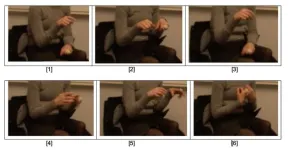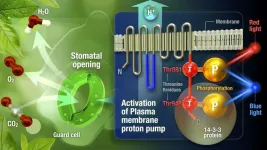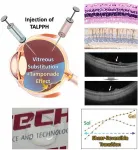(Press-News.org) Research Highlights:
Nontraditional risk factors for stroke were significantly associated with the development of strokes in adults younger than ages 35 to 45.
Migraine was the most important nontraditional risk factor for stroke among both men and women, according to the study of adults in Colorado.
Embargoed until 4 a.m. CT/5 a.m. ET Tuesday, March 26, 2024
DALLAS, March 26, 2024 — Adults younger than 35- to 45-years old may have a higher risk of developing a stroke from nontraditional risk factors such as migraines than from traditional risks like high blood pressure. That’s according to new research published today in Circulation: Cardiovascular Quality and Outcomes, a peer-reviewed American Heart Association journal.
Most strokes are caused by traditional stroke risk factors, such as high blood pressure, high cholesterol, Type 2 diabetes, smoking, obesity, low physical activity, alcohol abuse or coronary heart disease. However, recent data showed an increased incidence of strokes even among young adults without these risk factors, according to the study.
“We wanted to understand which risk factors were the top contributors to stroke risk among young adults,” said study lead author Michelle Leppert, M.D., M.S., M.B.A., FAHA, an assistant professor of neurology at the University of Colorado School of Medicine in Aurora, Colorado.
Using an administrative database of health insurance claims reported in Colorado, researchers matched data of more than 2,600 people who had strokes to more than 7,800 people who did not to determine which risk factors may most often lead to strokes.
The analysis found that nontraditional stroke risk factors, such as migraines, blood clotting disorders, kidney failure, autoimmune diseases or malignancy, were significantly associated with the development of strokes in men and women 18- to 44-years old. The association between stroke and nontraditional stroke risk factors was stronger in adults younger than 35 years old.
Results also showed:
Among 18- to 34-year-olds, more strokes were associated with nontraditional risk factors (31% in men and about 43% in women) than traditional risk factors (about 25% in men and more than 33% in women).
Migraine was the most important nontraditional stroke risk factor among 18- to 34-year-olds, accounting for 20% of strokes in men and nearly 35% in women.
The contribution of traditional stroke risk factors peaked among adults aged 35-44 and were associated with nearly 33% of strokes in men and about 40% in women.
In the 45-55 age group, nontraditional risk factors accounted for more than 19% of strokes in men and nearly 28% in women.
High blood pressure was the most important traditional stroke risk factor among 45- to 55-year-olds, accounting for 28% of strokes in men and about 27% in women.
Each additional traditional and nontraditional risk factor was associated with increased risk of stroke in all sex and age groups.
“These findings are significant because most of our attention has been focused on traditional risk factors,” Leppert said. “We should not ignore nontraditional stroke risk factors and only focus on traditional risk factors; both are important to the development of strokes among young people.
“In fact, the younger they are at the time of stroke, the more likely their stroke is due to a nontraditional risk factor,” she said. “We need to better understand the underlying mechanisms of these nontraditional risk factors to develop targeted interventions.”
Researchers were surprised to find that non-traditional risk factors were equally important as traditional risk factors in the development of strokes in young men and women. Leppert added that the large contribution that migraine headaches had in the development of strokes was also unexpected.
“There have been many studies demonstrating the association between migraines and strokes, but to our knowledge, this study may be the first to demonstrate just how much stroke risk may be attributable to migraines,” Leppert said.
Study details, background and design:
Researchers collected data from 2012-2019 from the Colorado All Payer Claims Database, which mandates the submission of all commercial insurance, Medicaid and Medicare claims.
Among the study’s stroke cases selected from adults 18- to 55-years old, 52% were among women and more than 73% were ischemic (clot-caused) strokes, which occur when a vessel supplying blood to the brain is obstructed.
Individual race and ethnicity, based on insurance reporting, were missing for almost half of all participants.
Data for stroke cases and people who did have strokes were matched by sex, age, insurance type and pre-stroke period.
Cases were defined as someone admitted to a hospital with a primary diagnosis of ischemic stroke, hemorrhagic (bleeding) stroke or subarachnoid hemorrhage (bleeding in the space surrounding the brain).
Nontraditional stroke risk factors were defined as factors that are rarely the cause of stroke in older adults or unique to young adults and included: migraines, malignancy, HIV, hepatitis, thrombophilia (including history of deep vein thrombosis and pulmonary embolism), autoimmune disease, vasculitis, sickle cell disease, heart valve disease and renal failure. Hormonal risk factors, such as oral contraceptive use and pregnancy, were considered separately among women.
Traditional stroke risk factors were defined as well-established potential causes for stroke routinely considered for adults ages 65 and older and included: high blood pressure, Type 2 diabetes, high cholesterol, sleep apnea, peripheral artery disease, atrial fibrillation, coronary artery disease, alcohol abuse, substance abuse, tobacco use, obesity and congestive heart failure.
The study had several limitations including its reliance on an administrative database, which could impact how risk factors were noted, and because it lacked data about race and ethnicity for many participants. Also, the research was conducted in metro areas one mile or more above sea level, so altitude may create unique conditions that are not applicable to people living at other altitudes.
Co-authors, disclosures and funding sources are listed in the manuscript.
Studies published in the American Heart Association’s scientific journals are peer-reviewed. The statements and conclusions in each manuscript are solely those of the study authors and do not necessarily reflect the Association’s policy or position. The Association makes no representation or guarantee as to their accuracy or reliability. The Association receives funding primarily from individuals; foundations and corporations (including pharmaceutical, device manufacturers and other companies) also make donations and fund specific Association programs and events. The Association has strict policies to prevent these relationships from influencing the science content. Revenues from pharmaceutical and biotech companies, device manufacturers and health insurance providers and the Association’s overall financial information are available here.
Additional Resources:
Multimedia is available on the right column of release link https://newsroom.heart.org/news/young-adults-with-migraine-other-nontraditional-risk-factors-may-have-higher-stroke-risk?preview=9e719a2c38220a9dbc7845f4d457469e
After March 26, 2024, view the manuscript online.
AHA news release: Black women with high blood pressure before age 35 may have triple the risk of a stroke (Feb. 2024)
AHA news release: $2.1 million awarded to research link between migraine, strokes and cardiovascular disease (July 2023)
Follow AHA/ASA news on X (formerly known as Twitter) @HeartNews
Follow news from the AHA’s Circulation: Cardiovascular Quality and Outcomes journal @CircOutcomes
###
About the American Heart Association
The American Heart Association is a relentless force for a world of longer, healthier lives. We are dedicated to ensuring equitable health in all communities. Through collaboration with numerous organizations, and powered by millions of volunteers, we fund innovative research, advocate for the public’s health and share lifesaving resources. The Dallas-based organization has been a leading source of health information for a century. During 2024 - our Centennial year - we celebrate our rich 100-year history and accomplishments. As we forge ahead into our second century of bold discovery and impact our vision is to advance health and hope for everyone, everywhere. Connect with us on heart.org, Facebook, X or by calling 1-800-AHA-USA1.
END
Young adults with migraine, other nontraditional risk factors may have higher stroke risk
Nontraditional risk factors such as migraines are as important as traditional risk factors like high blood pressure for adults younger than ages 35-45, finds new study in Circulation: Cardiovascular Quality and Outcomes journal
2024-03-26
ELSE PRESS RELEASES FROM THIS DATE:
New data offer reality check on blood-based colorectal cancer screening
2024-03-26
Bethesda, MD (March 26, 2024) – Modeling studies and expert consensus published today in the journals Gastroenterology and Clinical Gastroenterology and Hepatology shed new light on the promise and peril of liquid biopsy (blood tests) for colorectal cancer (CRC) screening that are currently in development.
“Based on their current characteristics, blood tests should not be recommended to replace established colorectal cancer screening tests, since blood tests are neither as effective or cost-effective, ...
Virginia Tech study considers ways to increase accessibility for all wildlife enthusiasts
2024-03-26
One in three birders experiences accessibility challenges to participation in birding, according to Virginia Tech researchers Emily Sinkular and Ashley Dayer.
“I like to think of our research as blending together two previously unconnected fields: disability studies and wildlife recreation,” said Sinkular, a Ph.D. student and lead author of the study published March 26 in the journal Human Dimensions and Wildlife. “There’s been quite a lot of research on disability and lots of research on birding, but very few researchers have combined these two topics together.”
The ...
From autism to Alzheimer’s: A large-scale animal study links brain pH changes to wide-ranging cognitive issues
2024-03-26
A global collaborative research group comprising 131 researchers from 105 laboratories across seven countries announces a groundbreaking research paper submitted to eLife. Titled "Large-scale Animal Model Study Uncovers Altered Brain pH and Lactate Levels as a Transdiagnostic Endophenotype of Neuropsychiatric Disorders Involving Cognitive Impairment," the study identifies brain energy metabolism dysfunction leading to altered pH and lactate levels as common hallmarks in numerous animal models of neuropsychiatric and neurodegenerative disorders, such as intellectual disability, autism spectrum disorders, schizophrenia, bipolar disorder, depressive disorders, and Alzheimer’s ...
Tiniest ‘starquake’ ever detected – new study
2024-03-26
An orange dwarf star has yielded the tiniest ‘starquakes’ ever recorded, measured by an international team of scientists.
Named Epsilon Indi, the star is the smallest and coolest dwarf star yet observed with solar-like oscillations – “starquakes” like those shown by the Sun. These oscillations provide indirect glimpses of stellar interiors – just as earthquakes tell us about Earth's interior – and so are important sources of information about the makeup of the star.
The measurements ...
Italians’ and Swedes’ gestures vary when they tell stories, which may show cultures think differently about narratives
2024-03-26
When we talk, we often use our hands in addition to words. Gesturing is a phenomenon that has been observed across languages and cultures. Some cultures are typically thought to use more gestures than others.
To find out if the deeply rooted stereotype of Italians gesturing more than other cultures is true, researchers in Sweden have examined the differences in gesture rate and function between Italians and Swedes who were telling a story to a friend.
“We show that Italians do gesture more than Swedes, which was expected,” ...
New treatment target identified for Alzheimer's disease
2024-03-26
Researchers at the University of Leeds and Lancaster University in the UK have identified a new potential target for the treatment of Alzheimer’s disease – PDE4B.
Alzheimer's disease is the leading cause of dementia and disability in old age. As the number of people diagnosed with Alzheimer’s disease is on the increase, new treatments are urgently needed to improve the quality of life for people living with the disease.
PDE4B is an enzyme inside cells that breaks down a molecule known as cyclic AMP, which regulates a range of cellular processes. Based on an Australian study that identified the ...
Discovery of amino acid unveils how light makes plants open
2024-03-26
Scientists from Nagoya University have discovered a novel regulatory mechanism that controls the opening of stomata in plants, which is crucial for harnessing solar energy through photosynthesis. The team uncovered the role of phosphorylation at the 881st threonine residue (Thr881) of the plasma membrane proton pump in response to red and blue light in this process. This research opens up possibilities for manipulating plant physiology in specific ways, benefiting agriculture and the environment. The researchers reported their findings in Nature Communications.
“This phosphorylation event, ...
Crackdown on illicit drugs detects rise in ‘designer’ drug substitutes
2024-03-26
As authorities crack down on illicit drugs, University of South Australia experts have issued an alert on the use of the synthetic stimulant pentylone, as new research finds a 75% increase in detections across Australia.
In a new study as part of the Australian Criminal Intelligence Commission’s National Wastewater Drug Monitoring Program, researchers identified 20 different novel psychoactive substances (NPS) in wastewater treatment plants across Australia (between Feb 22-23) with pentylone detected at every collection site. Other NPS, eutylone and phenibut were also commonly detected.
Pentylone, (street name ‘bath salts’), ...
Treatment for blindness-causing retinal detachment using viscous seaweed
2024-03-26
It’s taboo to consume seaweed soup before exams in Korea since it can lead to failing the exam. The belief is rooted in the idea that the slippery nature of seaweed may cause people to slip and falter during the test. The slick surface of seaweeds such as seaweed and kelp is attributed to alginate, a mucilaginous substance. Notably, an intriguing study exploring the use of alginate for the treatment of retinal detachment has been recently published.
A collaborative effort between Professor Hyung Joon Cha from the Department of Chemical Engineering and the School of Convergence Science and Technology and Dr. Geunho Choi from ...
More needs to be done for depressed stroke survivors as incidence climbs
2024-03-26
Researchers say more needs to be done for depressed stroke survivors as new findings show 60% of stroke survivors would experience depression within 18 years, a much higher estimation than previous studies.
This compares to 22% of the general population experiencing depression in the same time frame.
The King’s College London study, published today in The Lancet Regional Health – Europe, also found 90% of cases of depression occurred within five years of surviving a stroke, indicating a key time for healthcare intervention.
The findings, funded by the National Institute for Health and Care Research, looks at incidence of mild ...
LAST 30 PRESS RELEASES:
Injectable breast ‘implant’ offers alternative to traditional surgeries
Neuroscientists devise formulas to measure multilingualism
New prostate cancer trial seeks to reduce toxicity without sacrificing efficacy
Geometry shapes life
A CRISPR screen reveals many previously unrecognized genes required for brain development and a new neurodevelopmental disorder
Hot flush treatment has anti-breast cancer activity, study finds
Securing AI systems against growing cybersecurity threats
Longest observation of an active solar region
Why nail-biting, procrastination and other self-sabotaging behaviors are rooted in survival instincts
Regional variations in mechanical properties of porcine leptomeninges
Artificial empathy in therapy and healthcare: advancements in interpersonal interaction technologies
Why some brains switch gears more efficiently than others
UVA’s Jundong Li wins ICDM’S 2025 Tao Li Award for data mining, machine learning
UVA’s low-power, high-performance computer power player Mircea Stan earns National Academy of Inventors fellowship
Not playing by the rules: USU researcher explores filamentous algae dynamics in rivers
Do our body clocks influence our risk of dementia?
Anthropologists offer new evidence of bipedalism in long-debated fossil discovery
Safer receipt paper from wood
Dosage-sensitive genes suggest no whole-genome duplications in ancestral angiosperm
First ancient human herpesvirus genomes document their deep history with humans
Why Some Bacteria Survive Antibiotics and How to Stop Them - New study reveals that bacteria can survive antibiotic treatment through two fundamentally different “shutdown modes”
UCLA study links scar healing to dangerous placenta condition
CHANGE-seq-BE finds off-target changes in the genome from base editors
The Journal of Nuclear Medicine Ahead-of-Print Tip Sheet: January 2, 2026
Delayed or absent first dose of measles, mumps, and rubella vaccination
Trends in US preterm birth rates by household income and race and ethnicity
Study identifies potential biomarker linked to progression and brain inflammation in multiple sclerosis
Many mothers in Norway do not show up for postnatal check-ups
Researchers want to find out why quick clay is so unstable
Superradiant spins show teamwork at the quantum scale
[Press-News.org] Young adults with migraine, other nontraditional risk factors may have higher stroke riskNontraditional risk factors such as migraines are as important as traditional risk factors like high blood pressure for adults younger than ages 35-45, finds new study in Circulation: Cardiovascular Quality and Outcomes journal




